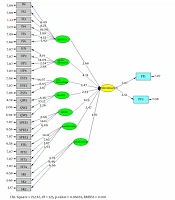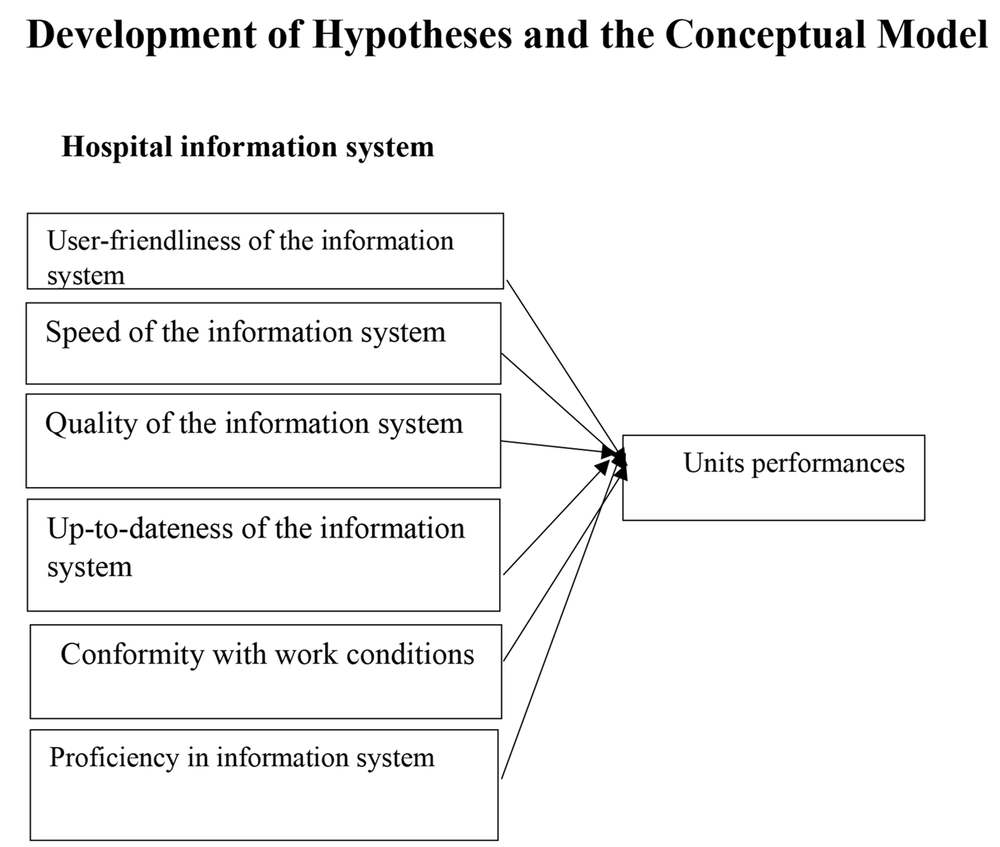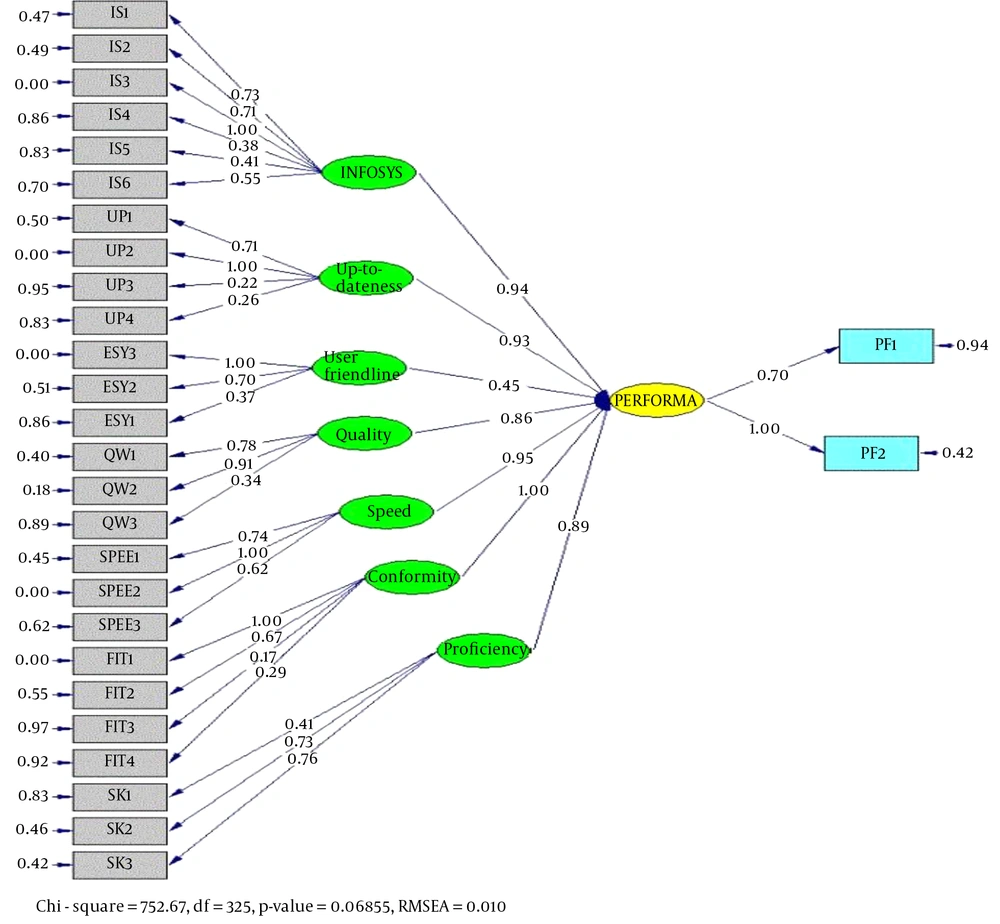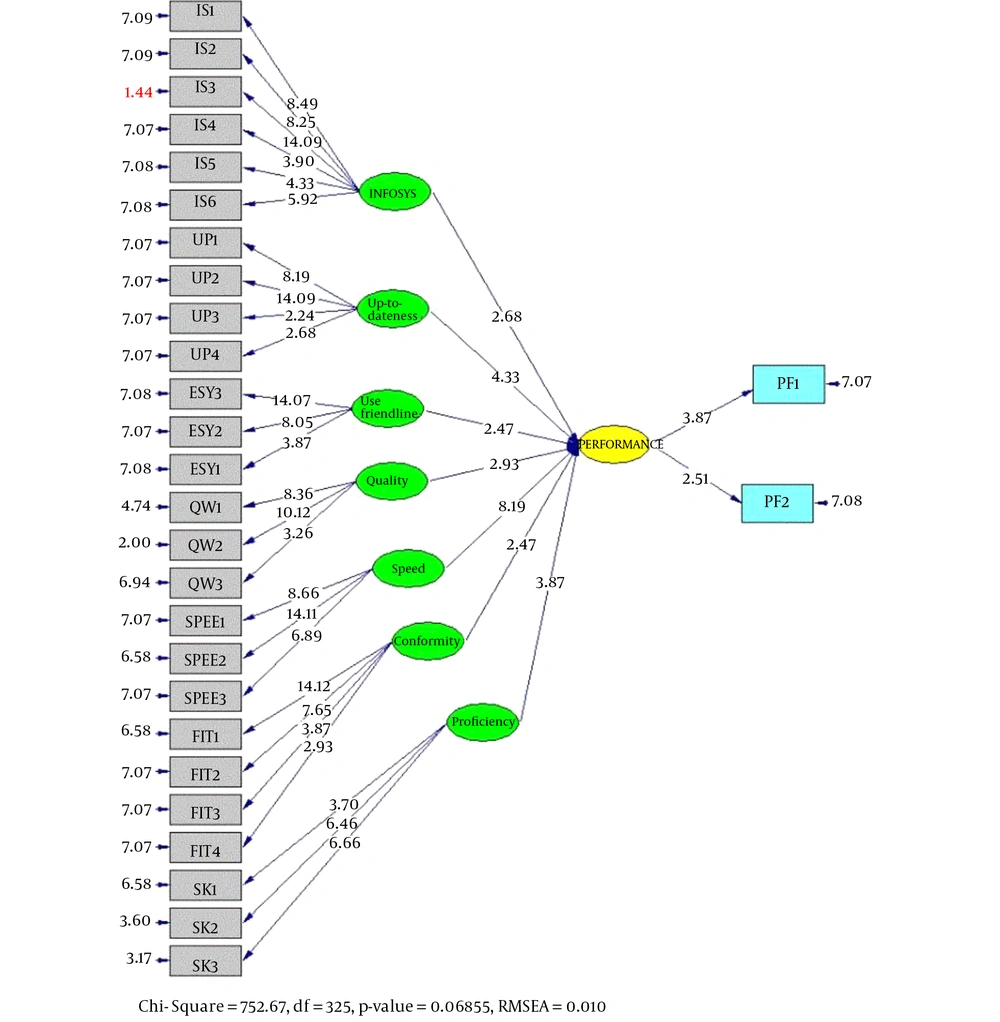1. Background
The history of computer usage in Iranian hospitals dates back to 1974 when computer systems were applied in the accounting units of Namazi, Faghihi, and Hafez hospitals of Shiraz and simultaneously in Pars Hospital of Tehran. However, healthcare information systems and hospital information systems (HIS) were seriously addressed by the Ministry of Health and Medical Education in 1998. The Ministry of Health issued a circular on the need for utilizing HIS in hospitals affiliated to Iran University of Medical Sciences. In the 1980s, some substantial and effective actions began throughout the country in terms of the development of medical software. The technical knowledge of companies active in the field of HIS was upgraded by forming training workshops. Documents were finalized during this decade, and a proposal was provided for a national HIS within the framework of e-health programs.
Management growth and development in the modern era rely on the information. Nothing moves without information, and generally, it is believed that information and its owners are powerful (1). On the other hand, many organizations are currently suffering from an excess of information. Therefore, they have to manage all the obtained information to overcome the chaos of the digital age caused by rapid technology development and extensive knowledge publishing (2). In this regard, the need for information systems has arisen (3). Therefore, to identify the activities and operation of any economic institution, it is necessary to achieve effective performance. The latter point could be realized by analyzing the information, structure of activities, and management style of the institution managers.
The success of information systems depends on identifying "information" knowledge, familiarity with "management information systems", understanding "computer technology", as well as designing and implementing "information systems". Another determining factor is the globalization of the market and loss of boundaries along with the use of information technology for exchanging business information across the world, which occur at an astonishing speed. Consequently, any institution that fails to exchange information will not be able to grow and develop. In order to deal with different circumstances and achieve the goals of an institution by considering the circumstantial variables, managers must necessarily analyze conditions, identify variables, and take appropriate measures. As a result, it is required to have timely access to and use information inside and outside the organization (4).
The HIS is a mechanism of information and document management in hospitals, which has various capabilities and values with the potential to bring about a revolution in hospital services. This system transfers quickly and accurately the instructions, recommendations, and medical services ordered by doctors for patients using computers. These changes are of high value in terms of work discipline in the work environments. In addition, time would be saved, and decision-making to treat the patient would be faster, resulting in a shorter duration of treatment and an increased level of patient satisfaction (5). Therefore, organizations have made huge investments in information systems as they are continuing their competition to stay in the market (6).
Some of the main reasons for collecting information in health and treatment centers include using health and treatment data for educational purposes, research, the development of medical and paramedical sciences, improving the quality of treatment, optimizing the management methods in health and treatment centers, and reducing the expenses of health centers (7). The impact of HIS on the performance of management units is well known. However, little research has been conducted on HIS payoff and how it influences the performance of management units. With this background in mind, the current study was designed to examine the effects of HIS on managerial performance in the public hospitals of Ahvaz, Iran.
1.1. Theoretical Background
1.1.1. Hospital Information System
The information/data of patient will have a considerable impact on the quality of patient care, as well as timely and appropriate decision-making. To achieve the goals of healthcare systems, information networks are essential. In such a network, patient information can be exchanged between hospitals and be used for patient care leading to reduced costs and increased quality of patient care, education, research, and information transfer to other people. Paper records need to be replaced with electronic records due to the limitations of paper usage for data transfer, such as illegibility, tearing, loss, incompleteness, high costs (e.g., 25% paper keeping costs), and being more time-consuming with 30% of the time of a doctor being spent on reviewing the papers (8).
The HIS is a subsystem of the health information system which was created in developed countries in the 1960s to support medical and administrative duties. However, the advent of these information systems in Iran dates back to two decades ago (9). Currently, this system is used as a common information system in Iran and is widely accepted and utilized in the hospitals of the country (10). In Iran, HIS is considered as one of the tools of health information technology used for daily hospital operations, planning, patient care, and the information needs of hospitals (9). This system can analyze hospital information in managerial, clinical, and administrative areas. In addition, it plays an important role in improving the quality and increasing the efficiency, effectiveness, and safety of services. Quality data are a prerequisite for quality information, better decision-making, and public health promotion (11). Therefore, the HIS should be able to store data accurately and timely retrieve information, as well as integrate, present, and exchange data with other users in the hospital environment.
1.2. Research Background
Thea Azeez and Yaakub (2) studied the effect of management information systems on organizational performance in a survey at Missan Oil Company, Iraq. Their results showed that Management information systems (MIS) indices, including information quality, user satisfaction, and net benefits, have a direct relationship with organizational performance. Ker et al. (12) investigated the impacts of health information systems on healthcare service improvement and the reduction of patient flow delays in a hospital in the US. The findings of the latter study indicated that the adoption of HIS had a considerable potential not only to reduce problems in the outpatient surgery unit but also to decrease the time and costs related to patient flow.
Saluvan and Ozonoff (13) examined the functionality of HIS by surveying quality directors in Turkish hospitals. They received responses from 31% of eligible institutions from all main geographical areas in Turkey. The mean availability of 50 HIS functions was 65.6%, with a range of 19.6 - 97.4%. The mean importance score was 7.87 on a 9-point scale varying from 7.13 to 8.41. Result management (89.3%) and decision-making support systems (52.2%) had the maximum and minimum availability, respectively. The perceived importance and availability had a moderate correlation (P = 0.522). Lu et al. (14) studied factors influencing the acceptance of HIS by nurses. The results of these authors showed that nursing care needs healthcare quality information to support the daily activities of nursing experts. Moreover, this research provided a valuable source for nurse managers to develop a HIS.
Ahmadian et al. (15) performed a study entitled “Assessing the Process of Requesting and Receiving Test Results from the Perspective of Nurses Before and After the Installation of HIS”. The data of their descriptive study was collected by interview, and their findings showed that from the nurses' point of view, HIS reduced workload to 85%, increased speed and accuracy to 85, 90% facilitated work, and 70% reduced the total time of application process and receiving test results. Amiresmaili et al. (16) conducted qualitative cross-sectional research entitled "Determining the Evaluation Indicators of HIS”. These researchers collected data using designed forms and interviews. The assessment of indicators demonstrated that despite the complexity of information system evaluation, all human, technical, and organizational aspects should be considered in each evaluation.
The main hypothesis, HIS characteristics have significant effects on the performance of individuals; Subhypothesis 1, the user-friendliness of HIS has a significant positive effect on the performance of units; Subhypothesis 2, the speed of HIS has a significant positive effect on the performance of units, Subhypothesis 3, the quality of HIS has a significant positive effect on the performance of units; Subhypothesis 4, the up-to-dateness of HIS has a significant positive effect on the performance of units; Subhypothesis 5, the conformity of HIS with work conditions has a significant positive effect on the performance of units; Subhypothesis 6, proficiency in HIS has a significant positive effect on the performance of units (Figure 1 and Table 1).
| Test Result | Significance | Path Coefficient | Hypothesis |
|---|---|---|---|
| Confirmed | 2.68 | 0.94 | The main hypothesis: The characteristics of HIS have significant effects on the performance of individuals in the units |
| Confirmed | 2.47 | 0.45 | Subhypothesis 1: The user-friendliness information system has a positive significant effect on the performance of individuals in the units |
| Confirmed | 8.19 | 0.95 | Subhypothesis 2: The speed of HIS has a positive significant effect on the performance of individuals in the units |
| Confirmed | 2.93 | 0.86 | Subhypothesis 3: The quality of HIS has a positive significant effect on the performance of individuals in the units |
| Confirmed | 4.33 | 0.93 | Subhypothesis 4: The up-to-dateness of HIS has a positive significant effect on the performance of individuals in the units |
| Confirmed | 2.47 | 1.00 | Subhypothesis 5: The conformity of HIS has a positive significant effect on the performance of individuals in the units |
| Confirmed | 3.86 | 0.89 | Subhypothesis 6: The Proficiency of HIS has a positive significant effect on the performance of individuals in the units |
Results of the Research Hypotheses
2. Methods
This applied study was performed through a descriptive survey, and the statistical population included 102 of the employees of Ahvaz public hospitals in 2015. The investigated units were accounting, cash desk, reception, and medical records, which are the supportive units and form a part of the management system in the treatment domain. Furthermore, the staff working in these units have access to the HIS. A stratified random sampling method was used, and the subjects in each stratum were selected out of all the members of the same stratum through simple random sampling.
The main data collection tool in this study was a questionnaire with general and specialized sections, including six subsections of user-friendliness (three items), speed (three items), quality (three items), up-to-dateness (four items), conformity with work conditions (four items), and proficiency (three items). The 5-point Likert scale was used to measure the attitudes of respondents (very low = 1, low = 2, medium = 3, high = 4, very high = 5). To measure the reliability of the questionnaire and ensure internal consistency, Cronbach’s alpha test was used. It should be noted that Cronbach’s alpha was more than 0.7 for all the variables in the questionnaire (Table 2).
| Number of Subjects | Number of Items | Cronbach Alpha | Title |
|---|---|---|---|
| 102 | 30 | 82/6 | All hospitals |
Source of Questionnaire Items and Reliability Coefficients of Research Variables
Descriptive statistics were used to examine the general questions of the questionnaire (i.e., demographic characteristics). In addition, inferential statistics were utilized to examine the specialized questions of the questionnaire. In inferential (parametric) statistics, the distribution of statistical samples was assessed by the Kolmogorov-Smirnov test. Moreover, the one-sample t-test was used to examine the status of research variables. Hypotheses were tested by structural equation modeling. Other influential issues and cases were evaluated using the one-way analysis of variance and independent samples t-test. All the analyzes were completed using the SPSS statistical software version 20.
3. Results
The analysis of the 101 studied samples revealed that 47.1 and 52.9% of the participants were men and women, respectively. The most frequent (42.4%) education level was a Bachelor’s degree. In terms of age, the age category of 30 - 40 years had the highest frequency (65.7%). Furthermore, the highest frequency in work experience was 47.1%, which was for a work experience of 10 - 20 years.
3.1. Research Model Fit
To reject or confirm the research hypotheses, the research conceptual model was assessed with LISREL software version 8.5. It should be noted that before testing the hypotheses, the model fit was also evaluated with this software. The number of indices presented to measure the model fit is constantly increasing, and there is no general agreement on an optimal test. Five indices are usually sufficient to validate a model. In this research, the indices used to evaluate the goodness of fit of the model entailed χ2, AGFI, GFI, RMR, CFI, NFI, NNFI, and RMSEA. Fit indices for the conceptual model of the research are shown in Table 3. According to Table 3, the path analysis model utilized in the present study suits the research objectives because the chi-square/df value of 2.31 was within the recommended range. The values for NFI, NNFI, CFI, and AGFI indices were all higher than 0.9, which is acceptable. Moreover, the RMSEA value was 0.01, which is in the permitted range.
| Results | Cut-Off Range | Value | Index |
|---|---|---|---|
| Acceptable | 1 - 5 | 2.31 | χ2/dF |
| Acceptable | NFI ≥ 0.9 | 0.91 | Normalized fit index |
| Acceptable | GFI ≥ 0.9 | 0.94 | Goodness of fit index |
| Acceptable | Close to 1 | 0.91 | Adjusted goodness of fit index |
| Acceptable | NNFI ≥ 0.9 | 0.91 | Tucker-Lewis index or non-normalized fit index |
| Acceptable | IFI ≥ 0.9 | 0.95 | Increased fitting index |
| Acceptable | CFI ≥ 0.9 | 0.94 | Comparative fit index |
| Acceptable | PNFI > 0.6 | 0.61 | Provided normalized fit index |
| Acceptable | RFI > 0.9 | 0.97 | Relative fit index |
| Acceptable | Close to 0 | 0.01 | Root mean square residual |
| Acceptable | RMSEA < 0.08 | 0.01 | Root mean square error of approximation |
Assessing the Fit of the Conceptual Research Model
3.2. Factor Analysis Results
To test the appropriateness of the selected questions for measuring the variables under investigation, confirmatory factor analysis was applied. In other words, the first step to examine the validity of a measurement model is to evaluate the fit of the variable measurement model. Figures 2 and 3 indicate the conceptual model of the research in standard and meaningful modes using structural equations by the LISREL software.
4. Discussion
The HIS is a mechanized system for document management in hospitals. Today, due to the use of modern and advanced technologies in medical information and the elevation in expectations of patients, a growing need for information systems in hospitals has arisen. Concerning the main hypothesis of the current research, it can be stated that the HIS characteristics have positive significant effects on the performance of individuals (P = 2.68). In other words, managerial decision-making based on real information results in improved management performance, which in turn increases the efficiency of hospital performance. As a result, hospitals need to establish and develop HIS to enhance their condition and employ trained professionals to offer practical information and knowledge.
Concerning the first subhypothesis, the findings of the present study are consistent with Azeez et al. (2) indicating a positive significant relationship between the user-friendliness of the information system and the performance of units in public hospitals (P = 2.47). Therefore, taking the judgments and opinions of users into account in the development and construction of information systems would promote efficiency and performance. Concerning the second subhypothesis, our results are consistent with the study performed by Asif et al. (7), and it can be concluded that the speed of HIS is significantly correlated with the performance of units (P = 8.19). Improvement in the speed of HIS imposes a significant impact on the enhancement of the efficiency of units, and ultimately on service delivery.
The findings of the present investigation about the third subhypothesis were compared with the findings of Ker et al. (12). The results revealed a significant relationship between the quality of HIS and the performance of units in the current study (P = 2.93). In case the quality of HIS improves and is supported continually, the performance of units will improve accordingly. In terms of the fourth subhypothesis, our results are in line with the findings reported by Thea Azeez et al. (2) and Lu et al. (14) with a significant relationship between up-to-dateness of HIS and the performance of units (P = 4.33). Therefore, it could be said that updating HIS and using the latest version of the system exert a positive influence on the provision of customer services along with improving the performance of units.
Regarding the fifth subhypothesis, our findings are compatible with those reported by Saluvan and Ozonoff(13). In the current study, a significant relationship was observed between the conformity of hospital information systems with work conditions and the performance of units (P = 2.47). Finally, concerning the last subhypothesis, the results of the present investigation showed a significant relationship between proficiency in using the HIS and the performance of units (P = 3.86). Therefore, training the staff and raising their proficiency level can positively affect the performance of units.
In conclusion, the results of the current study indicated that modern technologies are beneficial in improving the services offered to patients and clients in a shorter time and with better quality. Some approaches may improve hospital performance and help overcome weaknesses, such as applying different methods to get desired feedback from clients and patients, using the obtained feedback to evaluate performance and to take corrective actions, and increasing the flexibility of systemic methods and procedures. Moreover, training and running more specialized courses for the staff, encouraging them to take the initiative and perform their tasks in a better way through motivational issues, incorporating dynamic educational plans to update the information of staff about modern technologies and equipment can be of value. A number of other steps include enhancing the quality of activities and increasing proficiency to use modern technology in workplaces.
Future research can examine the impact of information system quality on the efficiency of hospital affairs and service delivery to patients. Considering the current needs of medical centers for information systems to provide patients with faster and better services, new management and operational systems should be evaluated.



